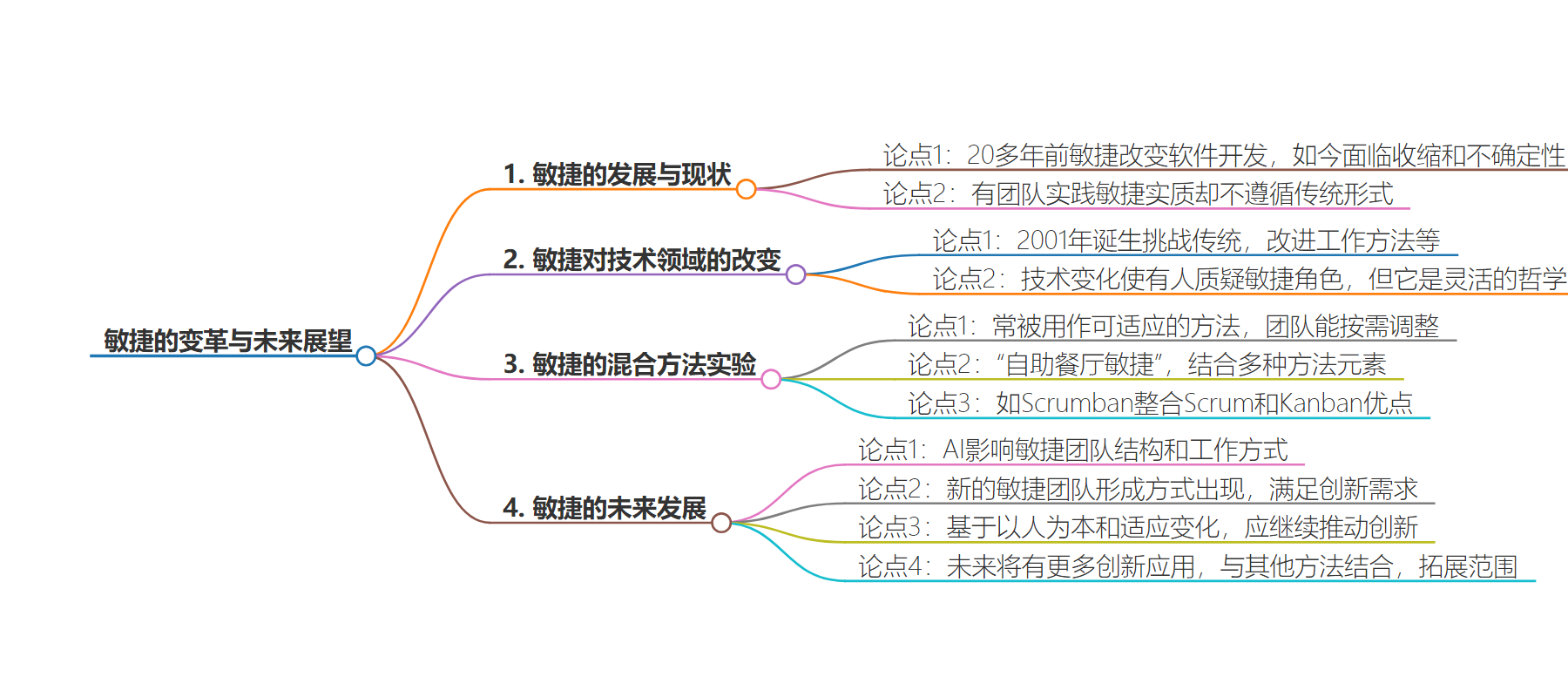包阅导读总结
1.
– `Agile`、`Evolution`、`Hybrid Approaches`、`Core Principles`、`Future`
2.
Agile 方法在过去 20 年改变了软件开发,如今面临质疑和变革。其核心原则仍重要,现多采用灵活适应需求的混合方法,未来应响应变化,以在多变的工作世界中成功。
3.
– Agile 的发展历程
– 20 多年前改变软件开发,现面临质疑和不确定性
– 从“Big A” Agile 到灵活实践,遵循核心原则
– Agile 的本质与价值
– 不是固定规则或通用框架,是赋能团队的方法和哲学
– 其价值观成为软件团队工作基础
– Agile 的创新与融合
– 采用灵活可变的方法适应特定需求
– 出现如 Scrumban 等多种混合方法
– Agile 的未来展望
– 受 AI 影响,需响应劳动力变化需求
– 与其他方法论结合,应用更广泛创新
思维导图:
文章地址:https://thenewstack.io/agile-reinvented-a-look-into-the-future/
文章来源:thenewstack.io
作者:Dave Ross
发布时间:2024/8/16 15:35
语言:英文
总字数:747字
预计阅读时间:3分钟
评分:89分
标签:敏捷方法论,软件开发,混合方法,选择式敏捷,AI 集成
以下为原文内容
本内容来源于用户推荐转载,旨在分享知识与观点,如有侵权请联系删除 联系邮箱 media@ilingban.com
Agile methodologies transformed software development over 20 years ago and have continued to evolve alongside technological advancements and shifting business practices. In fact, agile is currently undergoing a period of retrenchment and uncertainty, as some question its relevance and others find ways to reinvent agile for their specific needs.
I’ve seen software teams evolve away from “Big A” Agile (singular adherence to repetitive frameworks and practices) to “we don’t call it agile here.” As a scrum master, I joined a highly technical team that professed they hated agile but were doing all of the “agile-like” things — like flexible, iterative development as a small, empowered team that pivoted quickly to deliver hugely valuable regular releases — all without going through the traditional motions of Scrum. They practiced the substance of agile without all the fluff – and had the receipts to prove that it worked.
Still, amid such evolution, the original principles upon which agile is based — including flexibility and human-centricity—continue to guide teams in their pursuit of building the next big thing.
Transforming the Technology Landscape
Born in 2001, agile challenged traditional beliefs of software development. As an alternative to waterfall, it unleashed a wave of improvements in work methodologies, customer interactions, technical processes and product delivery.
The technology landscape has changed dramatically since then, and many are now questioning agile’s role. Some developers, particularly younger ones, dismiss agile as old-fashioned and inflexible.
But, at its core, agile is not a rigid set of rules or a one-size-fits-all framework. It’s an approach and a philosophy that empowers teams to embrace change, work together and deliver value continuously.
In recent decades, these values have become such foundational elements of software teams’ ways of working that people might not even realize they’re using aspects of agile. They may call themselves “product-led organizations,” but in embracing iterative development, customer collaboration and continuous improvement, they are embracing agile’s core values.
Experimenting With Hybrid Approaches to Agile
Today, agile is often used not as a fixed framework but as a malleable approach that teams can adapt to their distinct requirements. This has led to many agile methodologies designed to address specific contexts and needs.
Indeed, some teams and organizations practice “Cafeteria Agile” or combine elements or rituals from various agile methodologies according to their needs. Scrumban is an increasingly common methodology that integrates the structured stability of Scrum with the customer-centricity and transparency of Kanban — the best elements of both. Another example involves taking elements of the Spotify model, such as Squads and Guilds, and combining them with the ShapeUp framework’s six-week development cycle.
These hybrid approaches allow teams to enjoy the benefits of agile — greater agility, improved collaboration and better software quality — without being constrained by a single rigid framework.
Embracing the Past to Build the Future
There’s no denying that agile is poised at a pivotal juncture, especially given the advent of AI. While no one knows how AI will influence agile in the long term, it is already shaping how agile teams are structured and how its members approach their work, including using AI tools to code or write user stories and jobs to be done.
To remain relevant and impactful, agile must be responsive to the evolving needs of the workforce. Younger developers, in particular, seek more room for creativity. New approaches to agile team formation—including Team and Org Topologies or FaST, which relies on elements of dynamic reteaming instead of fixed team structures to tackle complex work—are emerging to create space for innovation.
Since agile was built upon the values of putting people first and adapting to change, it can, and should, continue to empower teams to drive innovation within their organizations. This is the heart of modern agile: not blindly adhering to a set of rules but embracing and adapting its principles to your team’s unique circumstances.
As agile continues to evolve, we can expect to see it applied in even more varied and innovative ways. For example, it already intersects with other methodologies like DevSecOps and Lean to form more comprehensive frameworks. Its scope will expand beyond software development and transform new domains and industries.
The future of agile is bright. It will be characterized by customization, integration, and adaptability. Teams that embrace this mindset will be well-equipped to succeed in a rapidly changing world of work.
YOUTUBE.COM/THENEWSTACK
Tech moves fast, don’t miss an episode. Subscribe to our YouTubechannel to stream all our podcasts, interviews, demos, and more.
